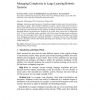Free Online Productivity Tools
i2Speak
i2Symbol
i2OCR
iTex2Img
iWeb2Print
iWeb2Shot
i2Type
iPdf2Split
iPdf2Merge
i2Bopomofo
i2Arabic
i2Style
i2Image
i2PDF
iLatex2Rtf
Sci2ools
JIRS
2000
2000
Managing Complexity in Large Learning Robotic Systems
Abstract. Autonomous learning systems of significant complexity often consist of several interacting modules or agents. These modules collaborate to produce a system which, when viewed as a whole, exhibit behaviour that can be interpreted in some way as learning. In designing these systems, the complexity of the interactions of large numbers of modules can become overwhelming, making debugging difficult and obscuring the workings of the system when viewed from an architectural level. A way of controlling system complexity called the Layered Learning System architecture (LLS) has been developed, which offers the advantages of incremental development and testing, easier debugging and progressive upgrading facilitation. A hexapod robot has been implemented using LLS principles, with the main learning task being that of learning to walk as fast as possible without falling over. Key words: distributed control system, learning system architecture, layered systems, mobile robots, walking robo...
| Added | 19 Dec 2010 |
| Updated | 19 Dec 2010 |
| Type | Journal |
| Year | 2000 |
| Where | JIRS |
| Authors | Kynan Eng, Alec P. Robertson, Deane R. Blackman |
Comments (0)

